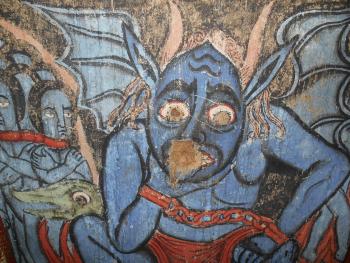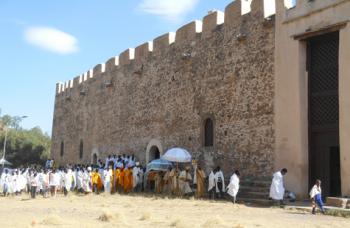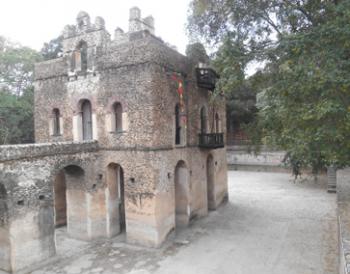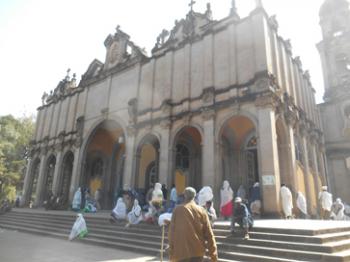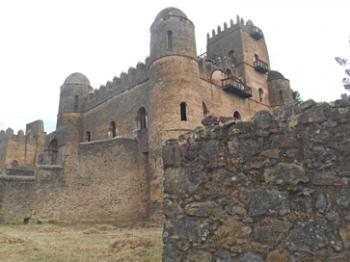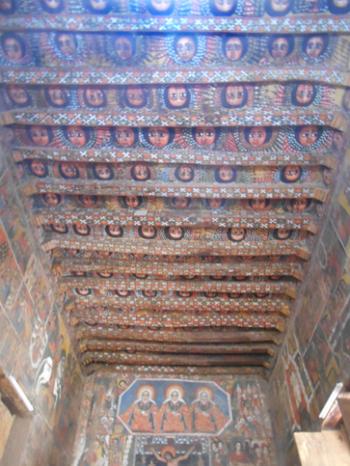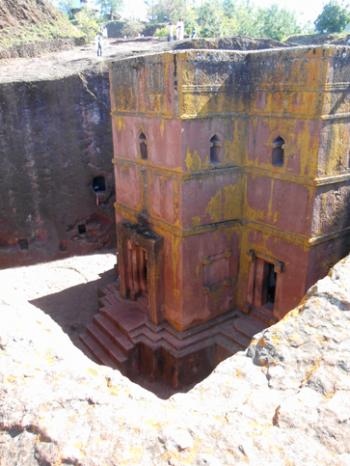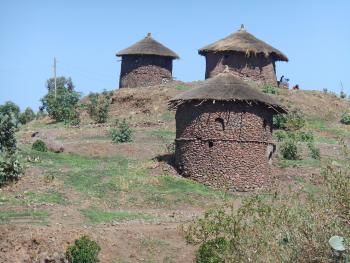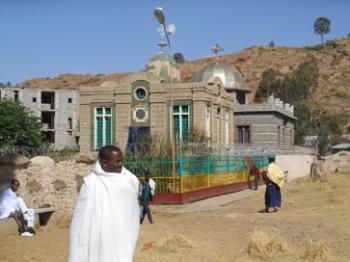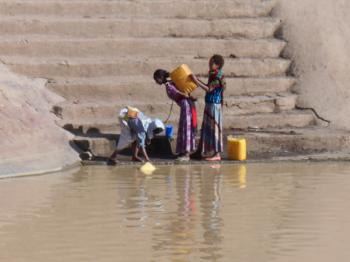Private Ethiopia tour with Awaze
This item appears on page 24 of the August 2017 issue.
For 37 years, I had wanted to visit Ethiopia. Finally, early in 2017, I contacted Awaze Tours (Haile Gebrselassie Rd., Addis Ababa, Ethiopia; phone +251 11 663 4439, www.awazetours.com), a company I learned about from the Bradt travel guide “Ethiopia,” by Philip Briggs, and from recommendations on Trip
Advisor.com.
Habte Fentaw, Awaze Tours’ founder and manager, was informative, helpful and supportive in his rapid responses to my queries. He arranged a private 7-day, 6-night tour of Ethiopia’s Northern Historical Circuit for March 8-14, 2017.
Excluding international flights, the cost of $1,400 plus a $200 single supplement covered four internal flights plus hotels, meals, transportation, guide services and entrance fees. (The price reflected a $375 discount for using Ethiopian Airlines for international flights.) I had overnight stays at Gondar, Lalibela, Axum, Addis Ababa and Bahir Dar.
Each of my tour guides was friendly, helpful and knowledgeable, with good communication skills. I learned a great deal about the history and culture of a beautiful country.
My itinerary included three UNESCO World Heritage Sites, all of which were inspiring. I hadn’t expected to find such quality sightseeing in the Horn of Africa.
Gondar is famous for the UNESCO site of Fasil Ghebbi, a walled medieval city of castles, churches and other buildings associated with King Fasilides and his descendants. My lodgings in Gondar were at the Goha Hotel (gohahotel.com), where there was a platform offering excellent views of the city and castles. I was intrigued by Fasil Ghebbi.
About 2 kilometers west of there, King Fasilides built a sunken bathing pool, enclosed by a stone wall with six turrets, for ceremonial purposes.
Debre Berhan Selassie is another of Gondar’s must-see sights. This small, beautiful church was consecrated in 1693. Among the impressive art covering the church’s corners, ceiling and walls was the colorful display of 80 cherubic faces painted in rows on the ceiling.
The crown jewel of the entire itinerary was my 2-day stay in Lalibela, another UNESCO site. The terrace of my room at the Panoramic View Hotel (www.panoramicviewhotel.com) enticed me with its scenes of the village set among plateaus, mountains, valleys and craggy rock formations.
Lalibela’s 11 fantastic, rock-hewn churches are considered to be some of the most impressive historical sites in Africa south of Egypt. The complex consists of subterranean monoliths carved deep into granite bedrock and connected by a network of narrow pathways, ledges and tunnels. Among the churches, the magnificent Bete Giyorgis stands off by itself in the southwestern area of the complex.
Many medieval monasteries are located around Lalibela. In the afternoon, my guide took me to Nakuta La’ab, a cave monastery located about 6 kilometers from town. The climb down into the cave was an adventure in itself, but the treasures the priest proudly showed off made the effort extremely worthwhile.
Axum was the third UNESCO site on my itinerary. My hotel, the Sabean International Hotel (Aksum; www.sabeanhotel.com), was conveniently located in the town center only a short distance from Stelae Park.
The tallest of the engraved granite obelisks in the park stands nearly 80 feet tall. Kings of the Axumite Empire commissioned the stelae as monuments to their glorious reigns. There is an excellent on-site museum that displays many artifacts and portrays the history of the area on colorful posters painted by a local artist.
Adjacent to Stelae Park is the complex of the Cathedral of Maryam Tsion (St. Mary of Zion). The interior of the new church is colorful, but the gem of the complex is the old church that was built in the 17th century by Emperor Fasilides. It contains wonderful paintings and musical instruments. I was privileged to see the interior. (By tradition, it is open only to men.)
On the day of my visit, when the daily Lenten fast ended at 3 p.m. I witnessed vibrant, crowded processions around each of the two churches. I also saw the exterior of the sacred chapel, located inside the complex, where it is said the Tabot, legendarily known as the Ark of the Covenant, is kept. (No one, other than its guardian, has ever been invited to see the Tabot, so many scholars question its existence.)
Afterward, my guide took me about 50 miles north along a rough road to a small shack to see the Ezana Stone and Inscription, a tablet written in three languages. The tablet was discovered by three farmers in the 1980s.
We then explored the ruins of Dongar Palace, which some scholars believe was the Queen of Sheba’s palace. On our way back to town, we stopped at May Shum, where the guide related the interesting background associated with the history of the pool, also called Queen of Sheba’s Pool.
Many visitors to Ethiopia skip its capital in their rush to get to the famous UNESCO sites. This is a mistake.
In Addis Ababa, my sightseeing included the Holy Trinity Cathedral, where Haile Selassie’s crypt is located.
The most important display in the National Museum of Ethiopia was the realistic replica of “Lucy” (known to Ethiopians as “Dinkinesh”), the 3.5-million-year-old Australopithecus africanus remains that were discovered in 1974, causing scientists to rethink the timing of humans’ development.
Another highlight was the visit to the IES Ethnographic Museum, installed in a former palace of Emperor Haile Selassie on the grounds of the main campus of Addis Ababa University.
Later, we navigated through the vast expanse of the Addis Mercado, where I enjoyed watching the frantic activity in various market stalls and shops. There was even a donkey parking lot.
After driving me up to Entoto Hill for marvelous panoramic views, my guide entertained a special request to show me the remains of original architecture in two of the oldest parts of the city: the Armenian Quarter and the Piazza District.
I spent the night at the Friendship International Hotel (Africa Avenue; www.friendshiphotel.com.et), near the airport.
The next morning I flew to Bahir Dar, where I was met by a local guide at the airport, got checked into the Avanti Blue Nile Resort and, at a dock nearby on Lake Tana, boarded a small boat for a cruise. We headed to the hippopotamus-infested outlet of the Blue Nile River.
Then we traveled to the Zege Peninsula to see the Azuwa Maryam church. Beautiful paintings and murals illustrating stories from the Old and New Testaments cover almost every square centimeter of the walls of this round church. I was dazzled and couldn’t stop taking photos.
After lunch at a lakeside restaurant, we walked through the Bahir Dar market, which I found to be more relaxed, friendlier and more fun than the Addis Mercado.
In the evening, my guide treated me to panoramic night views of Bahir Dar from Bezawit Hill on the east bank of the Nile.
Near Bahir Dar are the famous Blue Nile Falls. Unfortunately, due to the construction of a power-generating station, the volume of water flowing over the falls has been reduced from its original magnificence. Depending on the season (wet or dry), the flow is sometimes reduced to little more than a trickle. It was dry season during my visit.
We headed back to Addis Ababa, where I later was taken to the airport for a late-night flight home.
A quick word about foreigners entering Ethiopia — a visa is required for residents of most foreign countries, but there is a process for getting a visa upon arrival at Bole International Airport that is quick, painless and uncomplicated. At the time of my visit, a 30-day tourist visa for a United States citizen cost $50.
I found the tourism infrastructure in Ethiopia to be underdeveloped, and sometimes the going was a little rough, compared to a jaunt in Western Europe, but the sights were magnificent and unique, and the people seemed friendly, devout and generous.
If you’re interested in visiting Ethiopia, I highly recommend Awaze Tours. In my experience, their services were professional, caring and personalized.
THEODORE LIEBERSFELD
Boynton Beach, FL

